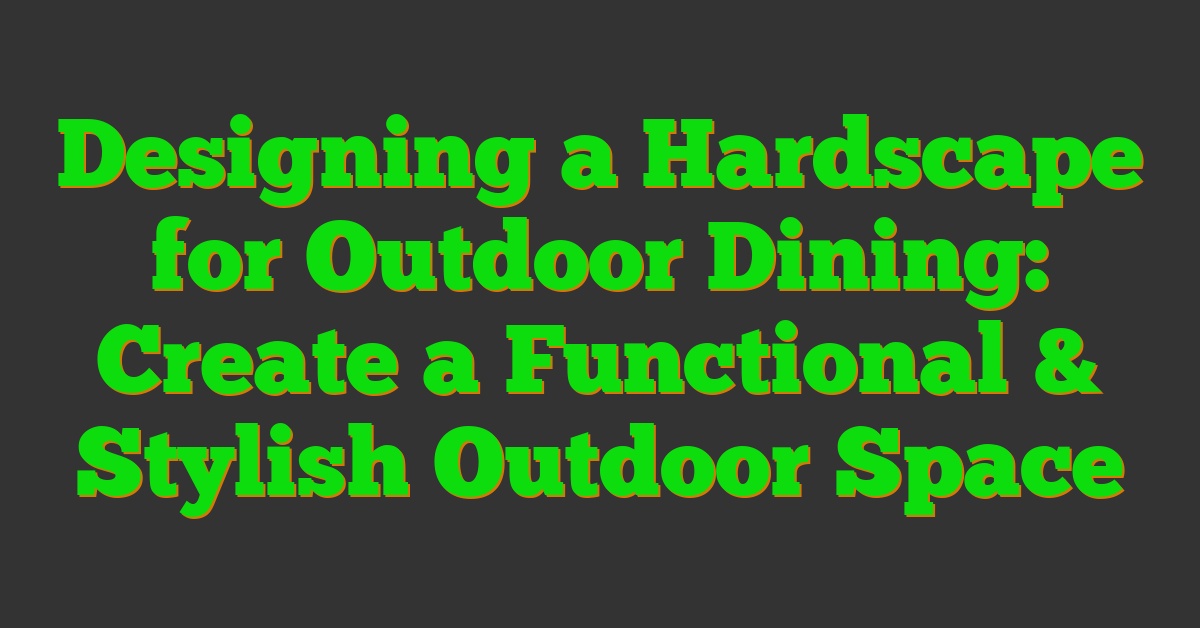Imagine savoring your favorite meal under the open sky, surrounded by thoughtfully designed hardscape elements that enhance your outdoor dining experience. I’ve always believed that the right hardscape can transform a simple meal into a memorable gathering.

From choosing the perfect patio materials to incorporating functional features like lighting and pathways, designing an outdoor dining space requires both creativity and practicality. In this article, I’ll share my insights on creating a hardscape that not only looks stunning but also serves your everyday needs.
Planning Your Outdoor Dining Hardscape
I start by assessing my space and defining my outdoor dining needs. This ensures a functional and attractive dining setup.
Assessing Space and Needs
Assessing my outdoor area establishes the layout and design components. I measure the space dimensions and inventory existing features, such as trees or fences. I identify necessary elements, like dining tables, chairs, and lighting, to tailor the hardscape appropriately.
Determining Seating Capacity
Determining my seating capacity defines the dining area’s dimensions and furniture arrangement. I decide the maximum number of guests, typically between 4 to 12, to ensure comfort and adequate movement. I select furniture sizes and table shapes that accommodate the chosen capacity efficiently.
Selecting Materials and Finishes
Choosing the right materials and finishes enhances both the durability and appearance of your outdoor dining area. I focus on selecting options that complement the space and withstand outdoor conditions.
Pavers and Stones
Pavers and stones provide a variety of textures and colors for outdoor dining setups. I select materials like natural stone, brick pavers, and concrete pavers based on durability and style. Natural stones include granite, slate, and limestone, each offering a distinct look. For example, granite pavers resist weather changes, making them suitable for different climates. Additionally, I arrange pavers in patterns such as herringbone or basketweave to add visual interest.
Concrete Options
Concrete offers versatile and cost-effective solutions for outdoor dining hardscapes. I use stamped concrete to replicate the appearance of natural stone or brick, allowing for customization without high costs. Sealing concrete surfaces protects against stains and weather damage, extending their lifespan. I also consider colored concrete options to match the dining area’s color scheme. Furthermore, permeable concrete allows water drainage, preventing pooling and maintaining a safe dining environment.
Designing Functional and Aesthetic Layouts
Creating a balanced layout enhances both the functionality and beauty of your outdoor dining area. I focus on key elements to achieve a harmonious space.
Seating Arrangements
Choosing the right seating maximizes comfort and accommodates guests efficiently. I consider the following options:
- Dining Tables: Opt for extendable tables to adjust for different group sizes.
- Benches: Provide a casual seating alternative and save space.
- Chaise Lounges: Add relaxation spots for guests before or after meals.
- Bar Stools: Integrate high tables for a modern touch and additional seating.
Spacing ensures easy movement. I allow at least three feet between furniture pieces, enabling guests to navigate without obstacles.
Pathways and Flow
Designing clear pathways enhances the dining experience by ensuring smooth movement. I implement these strategies:
- Wide Paths: Create paths at least four feet wide to accommodate foot traffic and wheelchair access.
- Curved Routes: Use gentle curves to guide guests naturally around the space.
- Material Consistency: Select paving materials that complement the hardscape, like natural stone or concrete pavers, to maintain a cohesive look.
- Lighting Integration: Incorporate pathway lighting to ensure safe navigation during evening gatherings.
Strategic pathway placement connects different areas, such as the dining space, kitchen, and garden, promoting an intuitive flow throughout the outdoor area.
Incorporating Lighting and Accessories
I enhance the outdoor dining area by integrating the right lighting and accessories to create a welcoming atmosphere.
Types of Outdoor Lighting
I choose from various outdoor lighting options to ensure functionality and ambiance:
- String Lights: Provide soft, ambient lighting above the dining area.
- Lanterns: Add a rustic touch to tables and pathways.
- LED Spotlights: Highlight architectural features and landscape elements.
- Solar Lights: Offer eco-friendly illumination along walkways.
- Fire Pits: Serve as both a light source and a gathering spot for warmth.
Decorative Elements
- Planters: Incorporate greenery and flowers to add color and life.
- Outdoor Rugs: Define the dining space and add texture underfoot.
- Cushions and Throws: Increase comfort and introduce patterns and colors.
- Sculptures and Art: Provide visual interest and reflect personal style.
- Water Features: Create soothing sounds and a tranquil environment.
Maintenance and Durability Considerations
Choosing durable materials minimizes long-term upkeep. I select natural stone, brick, or concrete pavers for their resilience against weather and heavy use. Regular cleaning prevents dirt buildup. Sealing surfaces every two years enhances resistance to stains and moisture.
Proper drainage ensures longevity. I design slopes that direct water away from dining areas, reducing the risk of erosion and water damage. Installing permeable pavers aids in effective drainage, especially during heavy rains.
Protecting furniture extends the hardscape’s life. I use weather-resistant materials for tables and chairs, placing cushions in sheltered areas to prevent mold. Covering furniture during harsh weather conditions adds an extra layer of protection.
Routine inspections identify wear and tear early. I check for cracked pavers or shifting stones, addressing issues promptly to maintain structural integrity. Replacing damaged elements quickly prevents larger problems down the line.
« Summer Maintenance Tasks for Your Landscape: Essential Tips for a Healthy Garden Best Shovels for Digging in Your Yard: Top Picks & Ultimate Buying Guide »
Implementing these maintenance strategies ensures the outdoor dining hardscape remains functional and attractive for years to come.
Conclusion
Designing a hardscape for outdoor dining has truly transformed my outdoor space into a welcoming oasis. Bringing together the right materials and thoughtful layouts made all the difference in creating memorable gatherings.
I’m excited for you to start your own hardscape project and see how it enhances your dining experiences. Embrace the process and enjoy the beautiful outdoor moments that await.
















